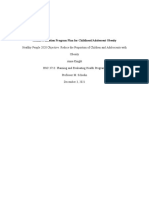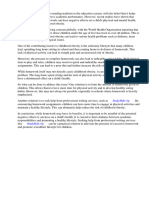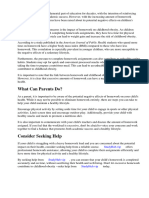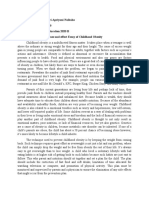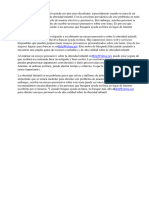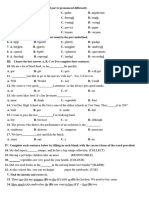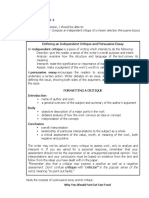Childhood Obesity Newsletter
Childhood Obesity Newsletter
Uploaded by
api-253381005Copyright:
Available Formats
Childhood Obesity Newsletter
Childhood Obesity Newsletter
Uploaded by
api-253381005Original Title
Copyright
Available Formats
Share this document
Did you find this document useful?
Is this content inappropriate?
Copyright:
Available Formats
Childhood Obesity Newsletter
Childhood Obesity Newsletter
Uploaded by
api-253381005Copyright:
Available Formats
What you need to know!
Childhood Obesity
What is Childhood Obesity?
this topic is now considered to be a very serious public health concern. The U.S. is currently the most obese county in the world. Nonetheless, after years of rising rates of childhood obesity over the last dec-
Healthy Carolinians
CHILDHOOD OBESITY HEATLH RISKS
Childhood obesity is defined as a condition Type 2 Diabetes where excess body fat negatively affects a High Cholesterol childs health or wellHigh Blood Pressure being. Research and Heart disease programs regarding Asthma childhood obesity typically include persons Sleep Apnea Gastroesophageal reflux between the ages of 513 although obesity can disease begin even earlier in Gall stones childhood. BMI Percentile Categories Due to the increase in childhood obesity rates throughout past years in the United States,
ade, there are encouraging signs, as the overall childhood obesity rate has started to even out and even slightly decline.
http://www.cdc.gov/healt hyyouth/obesity/facts.htm
Underweight<5th% Healthy Weight 5th-85th% Overweight 85th -95th% Obese 95th% or greater http://www.cdc.gov/ healthyyouth/ obesity/facts.htm
Determining Your Childs Weight Status
BMI is a great way to determine a childs weight status. BMI is a number that can be calculated from a childs height and weight. This method of weight measurement does not measure body fat directly but research has shown that BMI correlates to direct measures of body fat. This is a cheap and easy to perform method of screening for weight status. For more direct measure of body fat there are other methods that can be used such as underwater weighing and dual energy x-ray absorptiometry, however these methods are much more expensive.
http://www.cdc.gov/healthyyouth/obesity/facts.htm
Page 1
C H I L DH O O D O B E S I T Y
Healthy People Objectives 2020
Causes of Childhood Obesity
Sugary drinks and less healthy foods on school campuses Advertising of unhealthy foods Lack of daily physical activity in all schools Unsafe or unappealing place to be active or play Limited access to healthy affordable foods Increasing portion sizes Lack of breastfeeding support Increasing time spent in front of the television and computer. http://www.parenting.com/health -guide/childhood-obesity/causes
Increasing the proportion of elementary, middle, and high schools that require school health. Increasing the proportion of schools that offer nutritious foods and beverages outside of school meals. Reducing the proportion of children and adolescents who are considered obese.
http:www.healthypeople.gov/2 020/topicsobjectives2020/
What can we do?
Limit TV time Beware of sugary beverages such as soda and fruit juice Make sure kids are getting adequate sleep Dont allow children to skip meals, especially breakfast Eat more meals as a family Educate children Make sure kids are beings physically active Enroll your children in activities or after school sports. http://www.who.int/dietphysicalactivity/
Coping and Support
Be sensitive to your childs needs and feelingsFind reasons to praise your child's efforts celebrate incremental lifestyle changes Talk to your child about his or her feelings Help-
ing your child deal with his/her emotions or feelings is very important Help your child focus on positive goals Point out big and small milestones your child accomplishes http://www.who.int/ dietphysicalactivity/
C H I L DH O O D O B E S I T Y
Page 2
You might also like
- Overweight and Obese Children Reading Oet NoteDocument16 pagesOverweight and Obese Children Reading Oet NoteHarel Hevin100% (4)
- Final Program PlanDocument20 pagesFinal Program Planapi-547392304100% (1)
- Childhood Obesity BookDocument13 pagesChildhood Obesity Bookapi-282235174No ratings yet
- Childhood Obesity Speech 3Document5 pagesChildhood Obesity Speech 3sepit ketamNo ratings yet
- Major Performance Task Addressing Child in School: Pilar College of Zamboanga City, Inc. Basic Education DepartmentDocument3 pagesMajor Performance Task Addressing Child in School: Pilar College of Zamboanga City, Inc. Basic Education DepartmentAllyssa PackamNo ratings yet
- Obesity in Children OverviewDocument9 pagesObesity in Children OverviewthadikkaranNo ratings yet
- Childhood Obesity: Did You KnowDocument32 pagesChildhood Obesity: Did You Knowcris_moreniitaNo ratings yet
- Research EssayDocument10 pagesResearch Essayapi-639504287No ratings yet
- Does Homework Cause Childhood ObesityDocument5 pagesDoes Homework Cause Childhood Obesityg3z6e4zm100% (1)
- Childhood Obesity and Weight ProblemsDocument2 pagesChildhood Obesity and Weight Problemsnzw8088No ratings yet
- SM SAI NS RAJ A TU N AZL AN SHA H: Nutrition: ObesityDocument7 pagesSM SAI NS RAJ A TU N AZL AN SHA H: Nutrition: Obesitysofea1121No ratings yet
- Completed Final Paper Preventing Essay On Childhood ObesityDocument10 pagesCompleted Final Paper Preventing Essay On Childhood ObesityJeanne GarvinNo ratings yet
- Childhood ObesityDocument27 pagesChildhood ObesityAbuzdea AlexNo ratings yet
- Does Homework Contribute To Childhood ObesityDocument7 pagesDoes Homework Contribute To Childhood Obesitydwfuamapd100% (1)
- Homework and Child ObesityDocument8 pagesHomework and Child Obesityafodcauhdhbfbo100% (1)
- Overcoming Childhood Obesity. What You Must Know and How to Do It ProperlyFrom EverandOvercoming Childhood Obesity. What You Must Know and How to Do It ProperlyNo ratings yet
- Essay Childhood ObesityDocument2 pagesEssay Childhood ObesityChewfun KhooNo ratings yet
- 16 01 ExecsummaryDocument2 pages16 01 Execsummaryapi-255677957No ratings yet
- White Paper-Child ObesityDocument14 pagesWhite Paper-Child Obesityapi-252262472No ratings yet
- Teens, Youngsters and Weight Loss: The Art Of Slimming For The Typical TeenagerFrom EverandTeens, Youngsters and Weight Loss: The Art Of Slimming For The Typical TeenagerNo ratings yet
- Literature ReviewDocument5 pagesLiterature Reviewapi-609474293No ratings yet
- Childhood ObesityDocument6 pagesChildhood ObesityShannon TerrellNo ratings yet
- Childhood Obesity ResearchDocument12 pagesChildhood Obesity ResearchMarkNo ratings yet
- Running Head: The Answer To End Childhood Obesity 1Document10 pagesRunning Head: The Answer To End Childhood Obesity 1api-377321260No ratings yet
- Obesity in ChildrenDocument2 pagesObesity in ChildrenLorenn AdarnaNo ratings yet
- Obesity in ChildrenDocument15 pagesObesity in ChildrenJohn ConnorNo ratings yet
- Fastest Way To Burn Fat For ChildrenDocument2 pagesFastest Way To Burn Fat For Childrenevangelico123No ratings yet
- Childhood ObsityDocument6 pagesChildhood ObsityOgechi C AnyanwuNo ratings yet
- Foundation of Growth and Development: 7-Childhood ObesityDocument15 pagesFoundation of Growth and Development: 7-Childhood ObesityMarah aydiNo ratings yet
- Cause and Effect EssayDocument2 pagesCause and Effect EssayChika PutriNo ratings yet
- Teenage Obesity Thesis StatementDocument5 pagesTeenage Obesity Thesis Statementdwtnpjyv100% (2)
- Brestfeeding Defense ObesityDocument4 pagesBrestfeeding Defense ObesityChristine Notoningtiyas SantosoNo ratings yet
- Literature Review FinalDocument11 pagesLiterature Review Finalapi-253949835No ratings yet
- Persuasive Essay On Childhood ObesityDocument7 pagesPersuasive Essay On Childhood Obesitywrhkwohjf100% (1)
- Thesis RobinDocument153 pagesThesis RobinPriyaNo ratings yet
- How To Deal With Child ObesityDocument6 pagesHow To Deal With Child ObesityjayhowNo ratings yet
- Overweight in American ChildrenDocument14 pagesOverweight in American ChildrenMaruko KemNo ratings yet
- Hs 490 AssessmentDocument7 pagesHs 490 Assessmentapi-747354480No ratings yet
- Child Obesity Essay ThesisDocument8 pagesChild Obesity Essay Thesisdwsjyt34100% (2)
- Research ProposalDocument3 pagesResearch ProposalJen JessieNo ratings yet
- NewsletterDocument5 pagesNewsletterapi-257776463No ratings yet
- Does Homework Lead To ObesityDocument7 pagesDoes Homework Lead To Obesitycfnfwcb3100% (1)
- Literature Review Article On Childhood ObesityDocument8 pagesLiterature Review Article On Childhood Obesityc5qvf1q1100% (1)
- Example Thesis Statement For Childhood ObesityDocument5 pagesExample Thesis Statement For Childhood Obesityfjda52j0100% (2)
- LNG Assignment 2Document2 pagesLNG Assignment 2Akeneta RamNo ratings yet
- Childhood ObesityDocument6 pagesChildhood ObesitybonfaceNo ratings yet
- Brochure For Health PsychologyDocument2 pagesBrochure For Health Psychologycjelias0624No ratings yet
- 020 ObesityDocument2 pages020 ObesitychildobeseleedsNo ratings yet
- ObesityDocument3 pagesObesityJensenEweNo ratings yet
- English Paper Final Research PaperDocument8 pagesEnglish Paper Final Research PaperBriana Vincent100% (1)
- Childhood ObesityDocument9 pagesChildhood Obesityapi-357505423No ratings yet
- Childhood Obesity: Causes, Consequences and Prevention ApproachesFrom EverandChildhood Obesity: Causes, Consequences and Prevention ApproachesNo ratings yet
- Argumentative Essay On Childhood ObesityDocument4 pagesArgumentative Essay On Childhood Obesityibodduhjf100% (1)
- Literature Review HLTH 499Document8 pagesLiterature Review HLTH 499api-707978977No ratings yet
- Should Government Impose Restrictions On What Kinds of Foods Can Be Served in School CafeteriasDocument9 pagesShould Government Impose Restrictions On What Kinds of Foods Can Be Served in School CafeteriasharonNo ratings yet
- Text 3sDocument1 pageText 3sYounes SenouciNo ratings yet
- Good Thesis Statement For Child ObesityDocument7 pagesGood Thesis Statement For Child Obesityamandahengelfargo100% (2)
- Overweight and Obesity USA - 14.11.2024Document21 pagesOverweight and Obesity USA - 14.11.2024Hoan NguyenquocNo ratings yet
- Long-Term Obesity Prevention and The Motivating Adolescents With Technology To CHOOSE Health ProgramDocument9 pagesLong-Term Obesity Prevention and The Motivating Adolescents With Technology To CHOOSE Health ProgramispasNo ratings yet
- Remidi English Punya Sin SyinDocument14 pagesRemidi English Punya Sin SyinAnnisa Retno ArimdayuNo ratings yet
- (MrBi) Useful Language Banks For IELTS LearnersDocument11 pages(MrBi) Useful Language Banks For IELTS LearnersBùi Hải AnhNo ratings yet
- Immediate Download Childhood Obesity Contemporary Issues Society For The Study of Human Biology 1st Edition Noel Cameron Ebooks 2024Document84 pagesImmediate Download Childhood Obesity Contemporary Issues Society For The Study of Human Biology 1st Edition Noel Cameron Ebooks 2024nicaufrisku100% (10)
- Instant Download PHYSICAL ACTIVITY AND OBESITY 2ND EDITION Edition Bouchard PDF All ChaptersDocument81 pagesInstant Download PHYSICAL ACTIVITY AND OBESITY 2ND EDITION Edition Bouchard PDF All Chaptersbakesraperl0100% (1)
- Obesity: Carrie Miller, MSN, RN, CNEDocument30 pagesObesity: Carrie Miller, MSN, RN, CNEJeanIzeanNo ratings yet
- Decrease in Physical Education in SchoolsDocument7 pagesDecrease in Physical Education in Schoolsapi-328504289No ratings yet
- Role of Play Therapy in Childhood Grief: A Case Report: December 2016Document73 pagesRole of Play Therapy in Childhood Grief: A Case Report: December 2016Ram JayNo ratings yet
- LUẬN 2.1 -Ý KIẾN, QUAN ĐIỂM 1 PHÍADocument36 pagesLUẬN 2.1 -Ý KIẾN, QUAN ĐIỂM 1 PHÍAKiara NguyenNo ratings yet
- Choose The Word Whose Underlined Part Is Pronounced DifferentlyDocument4 pagesChoose The Word Whose Underlined Part Is Pronounced Differentlyk61.2211740096No ratings yet
- Quarter 3 - Week 4: En10Wc-Iiig-14 - Compose An Independent Critique of A Chosen Selection (Persuasive Essay)Document5 pagesQuarter 3 - Week 4: En10Wc-Iiig-14 - Compose An Independent Critique of A Chosen Selection (Persuasive Essay)Mikaela MosqueraNo ratings yet
- WhoDocument13 pagesWhoKCcheungNo ratings yet
- Cause and Effect ParagraphsDocument4 pagesCause and Effect ParagraphsRizky NatamaNo ratings yet
- Restrictive Feeding and Excessive Hunger in Young Children With Obesity: A Case SeriesDocument6 pagesRestrictive Feeding and Excessive Hunger in Young Children With Obesity: A Case SeriespingkyNo ratings yet
- Healthy Youth PRDocument1 pageHealthy Youth PRapi-468683480No ratings yet
- 2024 Article 659Document10 pages2024 Article 659danielesalles2011No ratings yet
- English Test Paper ANSWERDocument21 pagesEnglish Test Paper ANSWERTimmy SzeNo ratings yet
- Jurnal 4 Childhood ObesityDocument5 pagesJurnal 4 Childhood Obesitytri jayaningratNo ratings yet
- 11th English Answer KeyDocument30 pages11th English Answer Keyanandheeswaran.2007No ratings yet
- Review On Childhood Obesity: Discussing Effects of Gestational Age at Birth and Spotting Association of Postterm Birth With Childhood ObesityDocument10 pagesReview On Childhood Obesity: Discussing Effects of Gestational Age at Birth and Spotting Association of Postterm Birth With Childhood ObesityInternational Journal of Innovative Science and Research TechnologyNo ratings yet
- Paper 4 - RubricDocument6 pagesPaper 4 - RubricAndreaNo ratings yet
- IMOPH MinDocument10 pagesIMOPH MinMuhamadiahNo ratings yet
- Ped Obesity Flip Chart Maine FINALDocument24 pagesPed Obesity Flip Chart Maine FINALKhushi VermaNo ratings yet
- Sedentary Behaviors and Youth: Current Trends and The Impact On HealthDocument12 pagesSedentary Behaviors and Youth: Current Trends and The Impact On HealthVillateAngelaNo ratings yet
- Writing Persuasive Texts PowerPoint Year 5 and Year 6 Microsoft PowerPoint 24562.potxDocument20 pagesWriting Persuasive Texts PowerPoint Year 5 and Year 6 Microsoft PowerPoint 24562.potxMr. RamNo ratings yet
- Prevalence and Correlates of Adolescent Obesity Among Young Adults in South-Western NigeriaDocument12 pagesPrevalence and Correlates of Adolescent Obesity Among Young Adults in South-Western Nigeriaijmb333No ratings yet
- Final Draft The Epidemic of Child Obesity in America 112514Document14 pagesFinal Draft The Epidemic of Child Obesity in America 112514api-269040739No ratings yet
- The Positive Parent Raising Healthy Happy and Successful Children Birth Adolescence PDFDocument265 pagesThe Positive Parent Raising Healthy Happy and Successful Children Birth Adolescence PDFSyibly Avivy A. MulachelaNo ratings yet

